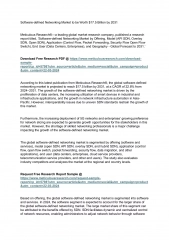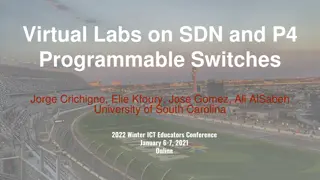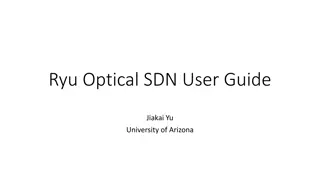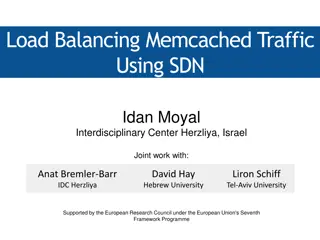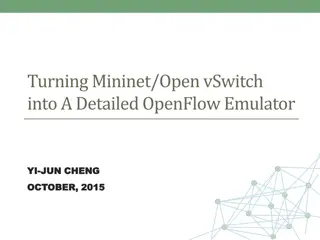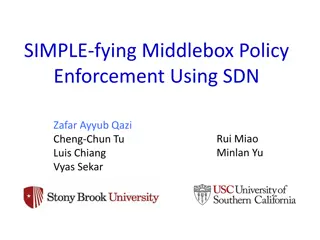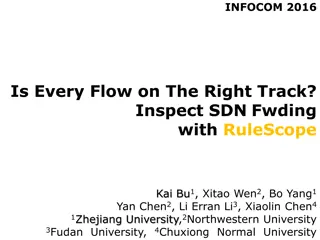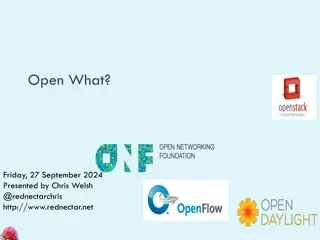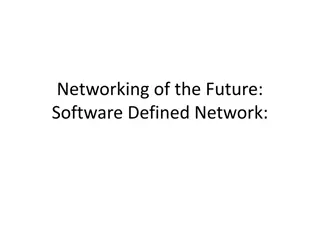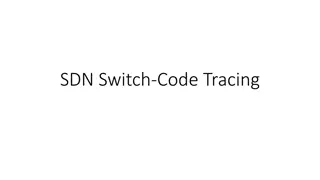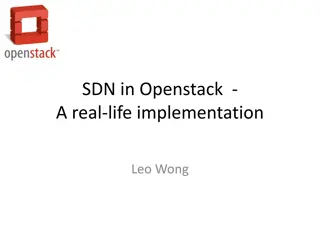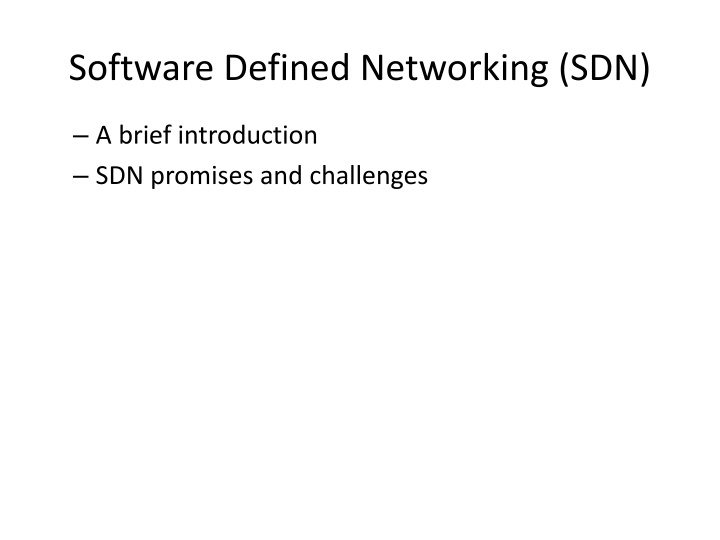
Software Defined Networking (SDN)
Learn about Software Defined Networking (SDN), its promises, challenges, and how it revolutionizes network control by exposing the underlying system to developers through APIs. Explore the transition from traditional networking to SDN, enabling programmability and customization for enhanced network management.
Download Presentation

Please find below an Image/Link to download the presentation.
The content on the website is provided AS IS for your information and personal use only. It may not be sold, licensed, or shared on other websites without obtaining consent from the author. If you encounter any issues during the download, it is possible that the publisher has removed the file from their server.
You are allowed to download the files provided on this website for personal or commercial use, subject to the condition that they are used lawfully. All files are the property of their respective owners.
The content on the website is provided AS IS for your information and personal use only. It may not be sold, licensed, or shared on other websites without obtaining consent from the author.
E N D
Presentation Transcript
Software Defined Networking (SDN) A brief introduction SDN promises and challenges
What is software defined? Software defined becomes a very popular word lately Software defined networking, software defined storage, software defined radio, etc. What is it? The control of the underlying system is exposed to the upper layer developer through an API. System functionality is implemented over the API as an app (software). This allows for customization for what users want. Another word for Software defined is Programmable
Todays router Tightly coupled data and control plane Hardware vendors also provide proprietary control software monolithic router contains switching hardware, runs proprietary implementation of Internet standard protocols (IP, RIP, IS-IS, OSPF, BGP) in proprietary router OS (e.g., Cisco IOS) Network Layer: Control Plane 5-4
Todays network Individual routing algorithm components in each and every router interact with each other in control plane to compute forwarding tables Routing Algorithm control plane data plane
Todays network Equipment vendors provide a set of routing (network control) choices: OSPF, RIP, ISIS, BGP, etc. Network control using a distributed, per router approach. Network administrator can change network parameters to achieve certain objectives: e.g. changing routes Limited programmability If one wants a new control mechanism (e.g. new routing services for data centers), (s)he is out of luck. This is what SDN tries to overcome: making the network control like an APP that user can develop by themselves. SDN is to make network control more programmable, easier to deploy new services.
Todays network New types of applications continue to be added using ad hoc approaches Core networking schemes remain unchanged. A lot of different middleboxes , each speaks its own language, and interferences with one another NAT, firewall, IDS, WAN optimizer, load balancer, traffic shapers, transparent web proxy, application accelerators, etc. Data plane elements are now interacting with many different types of control elements. How to make all these work (well) poses significant challenges.
SDN motivation Why do we want to make network control more programmable? Short term: Existing network control is no longer sufficient in several important areas, need innovation here! Data centers, Wireless, network security Existing network control is getting too complicated. Too many middleboxes with their own control Would be nice to provide a unified mechanism to deploy and manage these middleboxes Long term: programmability promotes innovation; and innovation is good for the networking industry.
Computing systems once upon a time Vertically integrated systems Proprietary hardware Proprietary OS Proprietary applications Highly reliable Dominated by a small number of large companies (IBM, HP, etc) Slow software innovation Proprietary development Small industry
Computing systems today Open interfaces Fast innovation o Everyone can participate Hugh industry Software is now part of everything. To promote innovation, we must make network systems like this! App App App App App App App App App App App Open Interface Windows (OS) Mac OS or or Linux Open Interface Microprocessor Microprocessor
Conventional networking system today Mainframe mindset: software for the control plane cannot be separated from the forwarding hardware in the data plane. o Vertically integrated, complex, closed, proprietary o Innovation is only possible if one has access to the router box. No significant innovation in the past 40 years. Custom hardware OS Bundled applications
Ideal networking system for innovation Network apps App App App App App App App App App App App Open Interface API of Net OS Net Net Mac OS Net Linux or or Network Operating Systems Windows Open Interface API for controlling Network hardware Network hardware (data plane only)
Ideal networking system for innovation App App App App App App App App App App App Separate hardware from software (data plane from control plane) Standardize the interface Each layer provides an abstraction Innovation is possible for anyone just like software development for a computing system. This is the vision of SDN/OpenFlow. Open Interface Net Net Mac OS Net Linux or or Windows Open Interface
SDN: separate forwarding hardware from controlling software 4. Firewall, virtual network, TE, IDS, etc App App App App App App App App App App App Open Interface Northbound API, not standardized yet Net Net Mac OS Net Linux 3. SDN controllers (floodlight, nox, etc) or or Windows 1. OpenFlow: standardized for Ethernet/IP/TCP Open Interface 2. OpenFlow enabled switches/routers simple hardware doing forwarding only forwarding table can be set by other entity through OpenFlow
SDN: Logically centralized control plane A distinct (typically remote) controller interacts with local control agents (CAs) in routers to compute forwarding tables Remote Controller control plane data plane CA CA CA CA CA
Why a logical centralized control plane? easier network management: avoid router misconfigurations, greater flexibility of traffic flows table-based forwarding (recall OpenFlow API) allows programming routers centralized programming easier: compute tables centrally and distribute distributed programming: more difficult: compute tables as result of distributed algorithm (protocol) implemented in each and every router open (non-proprietary) implementation of control plane Network Layer: Control Plane 5-16
Software defined networking (SDN) 4. programmable control applications routing 3. control plane functions external to data-plane switches load balance access control Remote Controller control plane data plane 2. control, data plane separation CA CA CA CA CA 1: generalized flow- based forwarding (e.g., OpenFlow)
SDN perspective: data plane switches Data plane switches fast, simple, commodity switches implementing generalized data-plane forwarding in hardware switch flow table computed, installed by controller API for table-based switch control (e.g., OpenFlow) defines what is controllable and what is not protocol for communicating with controller (e.g., OpenFlow) network-control applications routing load balance access control control plane northbound API SDN Controller (network operating system) southbound API data plane SDN-controlled switches
SDN perspective: SDN controller SDN controller (network OS): maintain network state information interacts with network control applications above via northbound API interacts with network switches below via southbound API implemented as distributed system for performance, scalability, fault-tolerance, robustness network-control applications routing load balance access control control plane northbound API SDN Controller (network operating system) southbound API data plane SDN-controlled switches
SDN perspective: control applications network-control apps: brains of control: implement control functions using lower-level services, API provided by SND controller unbundled: can be provided by 3rd party: distinct from routing vendor, or SDN controller network-control applications routing load balance access control control plane northbound API SDN Controller (network operating system) southbound API data plane SDN-controlled switches
How an SDN operates Network applications specify the network functions (not the detailed implementation on the physical devices): Access control: who can talk to who Isolation: who can hear my broadcasts Routing: only specify routing to the degree you care Some flows over satellite, others over landline TE: specify in terms of quality of service, not routes Network OS (or something like a compiler) compiles the network application and computes the configurations on physical devices based on the global view Network OS distributes the configuration to physical devices through the southbound interface (OpenFlow).
Contrast between SDN and conventional network SDN Conventional Controller may not be in the same box as the forwarding hardware Forwarding hardware and its control are in the same box Centralized routing algorithm with logically global view Distributed routing algorithm Network functions are realized with a global view Network functions must be realized in a distributed manner, error-prone New abstraction must be developed for the centralized view Network abstraction is embedded in the distributed algorithms
Major paradigm shift with SDN No longer use distributed control protocols Design one distributed system (NOS) with the global view of the network Use for all control functions Now just defining a centralized control function Configuration = Function(global view) This may look easy. But this is not how it is done before, everything is new innovation at all levels for this to happen.
Major paradigm shift with SDN This may look easy. But this is not how it is done before, everything is new innovation at all levels for this to happen. High level programming languages to describe network application. Runtime system to realize the program efficiently, correctly, and safely. Abstraction design Debugging infrastructure network OS design Scalability issues
SDN promises A lower-entry point for innovation in the network control. Solve the issues in the current network configuration challenges. Data plane interacts with many control entities Configure locally to achieve a global network function.
Some SDN issues that are currently under extensive research Abstraction A new programming system to specify network functions (programming SDN) An API that provides network abstraction to network application (SDN controller design) Performance (scalability) Controller Communication between controller and devices Forwarding Correctness and debugging A SDN program has a higher bar than a typical program, multiple levels Security

